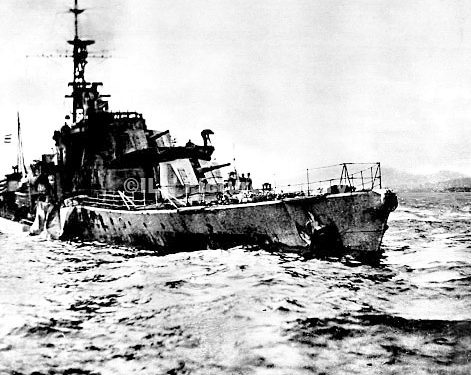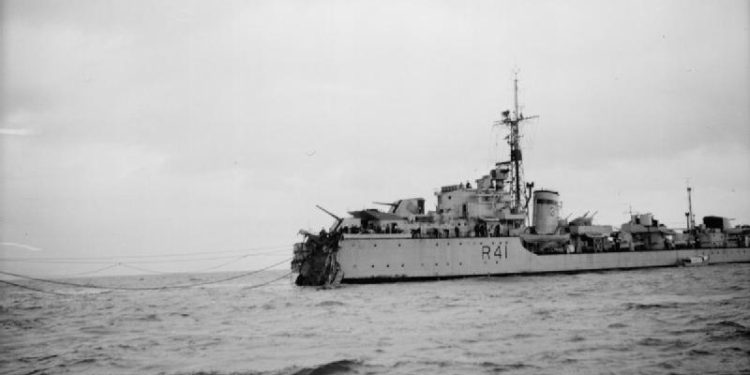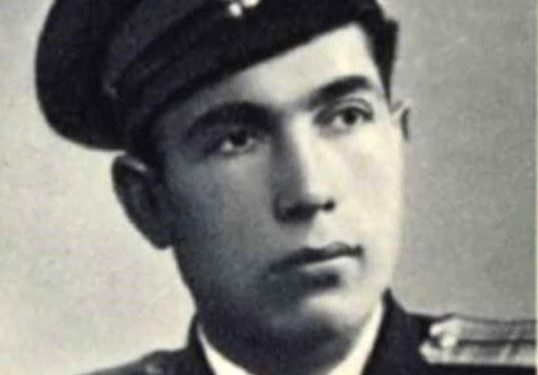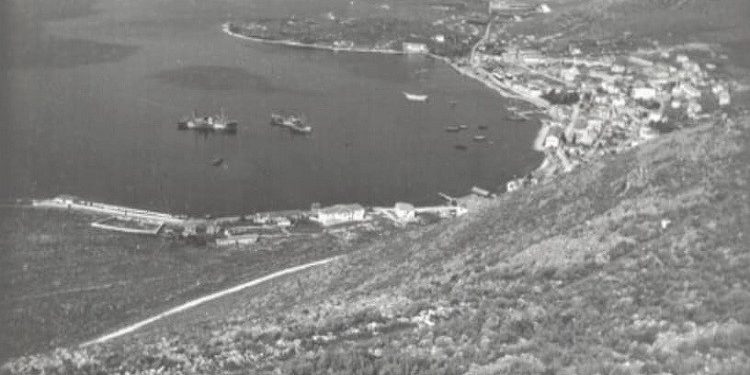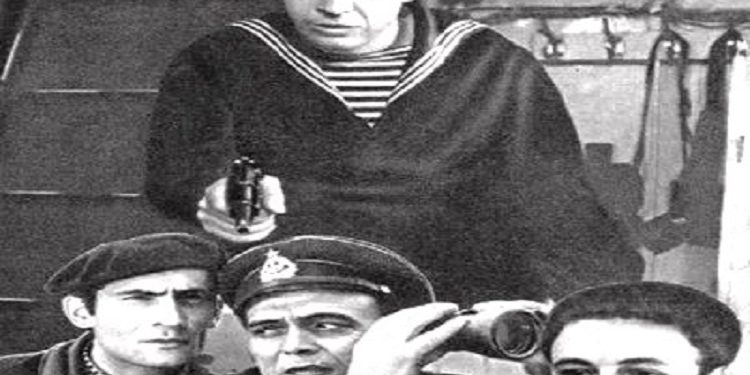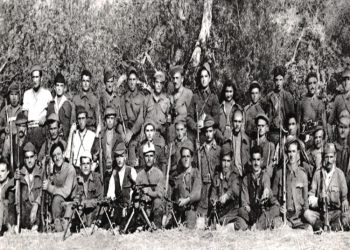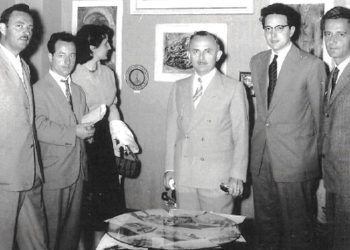By Artur Meçollari
Memorie.al / The adventure of the three sailors who hijacked the motorboat “Mujo Ulqinaku” and attempted to escape in the distant year ’47 is one of the most sensational events of the communist regime. It has been talked about and written about at length, a film has even been made, “Silent Duel”, but in no case has the full purpose of the dangerous adventure of the three sailors, who dared to hijack the ship and set off towards the “Promised Land” been fully clarified. It has not been said anywhere that the hijacked ship “Mujo Ulqinaku” had been part of the operation to mine the Corfu Channel and that one of its hijackers in ’47 had been present on that secret mission, which caused the terrible tragedy with the British ships, a year earlier.
It is a fact that the story of the hijacking of the motorboat “Mujo Ulqinaku” in 1947, after the fall of communism in Albania, has often been questioned, as has the heroic act of sailor Spiro Kote, who prevented the ship from crossing our waters. For understandable reasons, it has not been in the interest of propaganda to document the event, as it had happened. Ultimately, the unusual story has remained the attempted escape and the heroic act of sailor Spiro Kote.
Recent research to uncover the truth about the mining of the Corfu Channel in 1946 has also brought to light the role that the motorboat “Mujo Ulqinaku” had in this secret operation, the crew of which included the three sailors who attempted the escape. From many facts and further stated, it is proven that the purpose of the latter’s adventure was their arrival in The Hague, to testify to what they had seen with their own eyes, when Yugoslav sailors, on the orders of the Tirana dome, mined the bay of Saranda.
Today, after 80 or so years, there is no longer any doubt that the macabre act that caused the Corfu Channel incident and the death of 44 British sailors, was carried out in secret by the Yugoslav Navy, with the approval of the Albanian communist leadership of the time. The motorboat “Mujo Ulqinaku” was involved in the mining of the bay of Saranda, on September 19, 1946, and one of the sailors who would escape, Captain Vlash Bushi, had knowledge of the mining.
In an exclusive account, Captain First Rank, Artur Meçollari, former Deputy Commander of the Navy, argues with conviction that; Vlash Bushi, if the escape adventure were to be fulfilled, would be a reliable and indisputable witness in the Hague process
Mr. Meçollari, under what circumstances did the attempted escape of the motorboat “Mujo Ulqinaku” take place, in the distant year 1947?
On June 1, 1947, at around four in the afternoon, according to the report of the first officer and the commissioner of the Port of Durrës, Captain Ndoc Gjeluci and Captain Petro Prifti, Captain Vlash Bushi, the motorman of the motorboat “Mujo Ulqinaku”, together with sailors Xhemal Kërniqi and Enver Kruçi, part of the VI Company of the Navy, attempted to hijack the motorboat and escape to Italy, to continue further to appear as witnesses at the International Court of Justice. The motorboat, after leaving Cape Selita, was headed towards Brindisi.
However, the daring adventure of the three sailors did not go further. Seaman Spiro Kote, as soon as he discovered the purpose of that voyage, fought with them and killed all three of them on board the ship. Immediately after that, he took control of the ship himself and at around eight o’clock in the evening he returned and arrived at the Port of Durrës. According to the report of the two captains dated June 3 and the minutes of the seaman Spiro Kote, dated June 2, the elimination of the three sailors who hijacked the ship was made possible with the weapon that seaman Kote had hidden under the blanket.
In your notes from this story, you highlight the fact that the escape attempt of June 1, 1947, was related to the mining operation of the Saranda canal a year earlier, where 44 British sailors lost their lives…?!
It has already been proven that the mining operation was prepared with the agreement between Enver Hoxha and Tito, on August 19, 1946 in Bled (today Slovenia). There are many official documents already made public by Prof. Paskal Milo and Prof. Ana Lalaj, but they are not direct evidence for the carrying out of the mining.
The most complete and detailed evidence was provided by the former commander of the island of Sazan, Colonel Mevlan Dervishi, on October 29, 2010, before he passed away, given to Ilir Mati, journalist and son of the former commander of the Naval Combat Fleet, Rear Admiral Abdi Mati. Here is what he testifies: “In October 1946, I received a radiogram, considered highly secret, which ordered me to make myself available, for everything, to the first captain of the Navy, Abdi Mati.
Abdi came to Sazan and after a few days we boarded the Yugoslav ship and set off for Saranda. In Saranda, at night, coastal artillery fired on us. We returned to the island and the next day we set off again for Saranda, where in the dark the mines were laid. As far as I remembered, protective measures were being taken, due to the continuation of the war in Greece. In that Albanian mission, I was an observer, as was Abdi Mati. This is the truth. That’s all I know, that’s all I told you.”
What did the motorboat “Mujo Ulqinaku” have to do with the mining of the Bay of Saranda?
In a way, it was part of the secret operation. More precisely, it was present. The three Yugoslav ships entered Sazan on the evening of September 17, 1946. The Yugoslav ships made their first attempt to mine the bay of Saranda on the evening of September 18, but were hit by artillery from the Gjirokastra Division battery at Cape Qefali. The next day, on the evening of September 19, the ships completed the mining at midnight, unperturbed by the artillery, returned to Sazan on the morning of September 20, and sailed to Yugoslavia that same day.
At the time the three Yugoslav ships arrived in Sazan on September 17, Major Mevlan Dervishi had no information about their arrival and sent a phonogram to the Chief of General Staff, Major General Mehmet Shehu. The latter replied that they were allowed to enter Sazan. This proves that Captain Abdi Mati went to Sazan after the three ships arrived. The Captain of the Port of Vlora, Lieutenant Pali Carapuli, now deceased, indicated that Abdi Mati did not move from Vlora to Sazan.
Pali himself, with a sailor, on September 18 and 19, 1946, was ordered to Bristan (Karaburun), to follow and ensure the movement of Yugoslav ships. Abdi Mati moved from Durrës with the motorboat “Mujo Ulqinaku”, towards Sazan. “Mujo Ulqinaku”, was the largest, fastest motorboat and entered six months ago, in the inventory of the Military Navy
What evidence did the British present in the international court for the mining of the bay of Saranda by the Yugoslavs?
The British accused the Albanian side of having allowed the Yugoslav Navy to mine the bay of Saranda, or as it was expressed; The Corfu Channel. In my book “The Corfu Channel Incident: Perverted Justice”, I have argued that it was not the Corfu Channel that was mined, but the Gulf of Saranda, and that the incident of October 22, 1946, also occurred in the Gulf of Saranda.
For this, the British presented another scheme in The Hague, with two ships departing from Šibenik, after stopping in the Bay of Kotor, sailing towards Saranda and at midnight on October 19, 1946, carrying out the mining. The British scheme was built from the testimonies of two Yugoslav sailors, who also appeared at the Hague Tribunal about the incident and is found in the archives of the Ministry of Foreign Affairs.
What did the two Yugoslav witnesses say at the trial?
After the failed incident of the motorboat “Mujo Ulcinaku”, the British encouraged the escape of two Yugoslav sailors, Karel Kovačić and Živan Pavlov, to testify at the Hague trial. If Captain Vlash Bushi had escaped, he would have had complete testimony and would have been a reliable witness, since from 17 to 20 September 1946; he had been in Sazan and had seen the three Yugoslav steamers and the mines on board, as well as their movements.
However, the British scheme is close to the real scheme of the mining, except for the stay in Sazan and the date of the mining. In my judgment, Vlash Bushi had no direct connection with the British, since they had left a year earlier, but as an intermediary, he may have been the Italian intelligence. Captain Vlash Bushi had served in the Royal Albanian Navy when it was under Italian tutelage, and even its commander was an officer of the Italian Navy.
The Testimony of Karel Kovačić
Karel Kovačić was born in Ljubljana on July 30, 1914. He entered the Yugoslav Naval Academy on October 1, 1933. Before the war, he rejoined the Royal Yugoslav Navy. During the war, he was interned in several concentration camps in Italy. On March 14, 1944, he was promoted to captain of the third rank. He subsequently served in the Yugoslav Federal Navy as a navigator and minor on minesweepers. On October 6, 1947, Kovačić escaped from Yugoslavia and settled in England.
In his testimony issued to the British on 4 October 1948 and presented by the latter in court, he testified that: “About 18 October 1946, two ships (“Mljet” and “Meljine”) left the Port of Šibenik loaded with German mines of the GY type”. Karel Kovačić was called to testify in the public trial on 25 November 1947, where he testified that: “While I was standing on the terrace of my house in Šibenik, on 17 October 1946, at 16:20, I saw on the quay near the Panikovač cave (about one kilometre away) two minesweepers loading mines. This operation lasted about 1-1.5 hours and each of them left after having picked up about 20 naval mines”.
He also stated that; “an officer, whose name I cannot reveal, but who later stated that he was Sub-Lieutenant Drago Blazevic, had told him that those mines were laid in Albanian waters”. This officer, according to Kovačić, “had not participated in the operation, but had been told by another officer”.
Kovačić’s testimony was categorical and he tried to appear incontestable. After verification by a Hague expert commission in Šibenik, he reported that; “at 17:35 on the same day, it was impossible for witness Kovačić to observe anything, regardless of where the ships had landed in the Panikovac cave”. Karel Kovačić’s testimony was not taken into consideration by the Court.
Statement of Živan Pavlov
Živan Pavlov was born on 16 March 1916. Former sailor of the Royal Yugoslav Merchant Navy. During the war he was imprisoned by the Germans in the Greisfald Concentration Camp in Poland. In 1945, he was re-enlisted in the Merchant Navy of the Yugoslav Federation, but escaped from the ship on October 25, 1948 in Trieste, because as he stated in his testimony; “I had no sympathy for the regime in Yugoslavia”. The Yugoslav authorities accused him of desertion and as a suspicious person in relations with foreign services. In order to be as convincing as possible in his lawsuit against Albania, the British side did not rely solely on Kovačić’s testimony.
London officials dealing with the incident, on December 10, 1948, had obtained a statement from Živan Pavlov under suspicious circumstances, who testified that on October 27, 1946, he had seen a Yugoslav “M” class warship in the Bay of Kotor. In his statement Pavlov wrote that; “The visibility was good and we could see the ship, it was a ‘Meljine’ class minelayer. I am familiar with this type of ship, having served in the Royal Navy before the war”. During the consideration of Zhivan Pavlov’s testimony, the jury confirmed that it was unnecessary to hear it in open court and never took it into consideration.
The mystery of the sunken ship!
The mining of the Bay of Saranda, according to the testimony of Major Mevlan Dervishi and documentary evidence, was carried out by three Yugoslav ships on September 19, 1946. But there is no evidence of how many ships returned to Sazan on the morning of September 20. The British version speaks of two “M” class minesweepers, “Mljet” and “Meljine”. In 2008, the exploration ship “Hercules”, part of the underwater expedition of the American Institute of Archaeology, in cooperation with the Academy of Albanological Studies, discovered and filmed a shipwreck in the Bay of Burint.
This ship was also filmed by the diver and explorer Igli Pushtina, in 2022. The shipwreck in the Bay of Butrint is a ship manufactured before or during World War II. It may have been under water for over 70 years. The ship is located at a depth of 53 m. The footage clearly shows many naval mines on board the ship.
However, no state has claimed ownership of this ship, as part of its maritime history and heritage. I suspect that three ships left Sazani on September 19, 1946 to carry out the minelaying, but only two returned the next day. And it is believed that only the “M” class minesweepers returned. The disappearance of the test, the mines and the minelaying ship would keep the minelaying completely hidden.
Spiro Kote and the adventure with the ship “Mujo Ulqinaku”!
In June 1947, Spiro Kote was only 21 years old. On June 8, 1947, in Durrës, a ceremony was held to award seaman Spiro Kote, by the Presidium of the People’s Assembly, with the fully deserved title of “National Hero”. Spiro Kote would continue his career in the Naval Combat Fleet.
After studying in the former Soviet Union, in 1959, he would be one of the first four commanders of Albanian submarines. Then commander of the Great Dragamine in Sazan, ending his career in the position of deputy commander of the Durrës Naval Base. Sailor Spiro Kote, is the pride of the Navy, along with two other heroes of the people, Mujo Ulqinaku and Ilia Dashi.
The motorboat “Mujo Ulqinaku”, represents the new symbol of the rise of the National Military Navy, as it is one of the naval vehicles with the most glorious history in this period of the history of the Navy. The photo of the launching of the motorboat “Mujo Ulqinaku”, on April 23, 1946, represents and symbolizes the re-establishment of the Albanian Navy, with the symbolic date of August 15, 1945. On August 15, in fact, the motorboats MS-10 and MS-12 were launched.
The motorboat “Mujo Ulqinaku” served in World War II, in the service of the German army, in the Saranda region under the name “JO-84”. At the end of World War II, “JO-84” was hit by the British and sank in a semi-submerged state. The removal of “JO-84” from the water took place on September 21, 1945 and it was repaired at the Navy Shipyard in Durrës. Captain Anastas Qëndro was appointed commander of the motorboat “Mujo Ulqinaku”. The crew of the motorboat were assigned to the motorboat’s petty officer, Captain Vlash Bushi, seaman Spiro Kote, seaman Vasil Nasto, seaman Jorgji Sholla, etc. / Memorie.al




